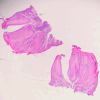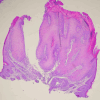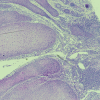Inverted Follicular Keratosis in a Young Female Patient: A Case Report of a Rare Occurrence
- PMID: 39996232
- PMCID: PMC11848229
- DOI: 10.7759/cureus.77907
Inverted Follicular Keratosis in a Young Female Patient: A Case Report of a Rare Occurrence
Abstract
This case report describes a rare occurrence of inverted follicular keratosis (IFK) in a 27-year-old woman who had a single lesion on the left side of her nose. IFK, which primarily affects older males, is a harmless condition that involves the hair follicles and sebaceous ducts. The patient's lesion, with a size of 0.4 x 0.3 x 0.3 cm, was surgically removed and subsequently identified as IFK through histopathological analysis. This case underscores the significance of including IFK in the list of potential causes for solitary keratotic lesions in younger patients and emphasizes the need for histopathological analysis to ensure an accurate diagnosis. After the surgical removal, the patient did not experience any return of the condition, which aligns with the positive outlook described in the medical literature.
Keywords: dermato-pathology; dermatology; differential diagnosis; histopathology; ifk; inverted follicular keratosis; solitary skin lesion; young female.
Copyright © 2025, Alfalah et al.
Conflict of interest statement
Human subjects: Consent for treatment and open access publication was obtained or waived by all participants in this study. Conflicts of interest: In compliance with the ICMJE uniform disclosure form, all authors declare the following: Payment/services info: All authors have declared that no financial support was received from any organization for the submitted work. Financial relationships: All authors have declared that they have no financial relationships at present or within the previous three years with any organizations that might have an interest in the submitted work. Other relationships: All authors have declared that there are no other relationships or activities that could appear to have influenced the submitted work.
Figures





References
-
- Inverted follicular keratosis. White DK, Miller AS, Burkes EJ, et al. J Oral Maxill Surg. 1985;43:498–503. - PubMed
-
- Inverted follicular keratosis. ME AH. Arch Dermatol. 1964;89:229–235. - PubMed
-
- David Weedon. Weedon's Skin Pathology (Third Edition) Churchill Livingstone; 2010. Tumors of cutaneous appendages; pp. 757–807.
-
- Infundibular tumors of the skin. Mehregan AH. J Cutan Pathol. 1984;11:387–395. - PubMed
Publication types
LinkOut - more resources
Full Text Sources
